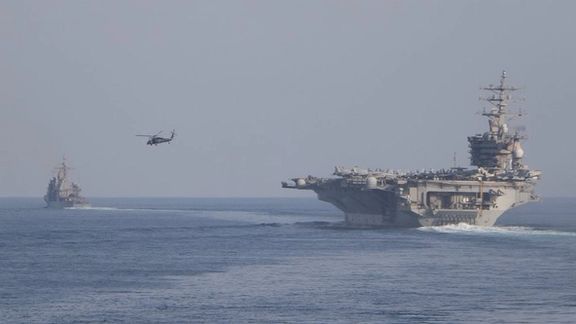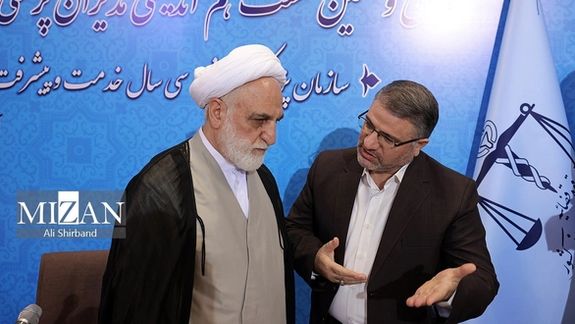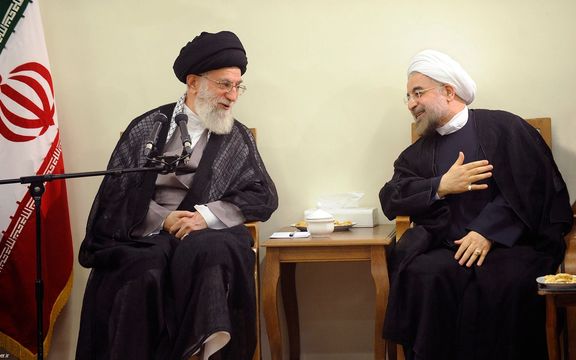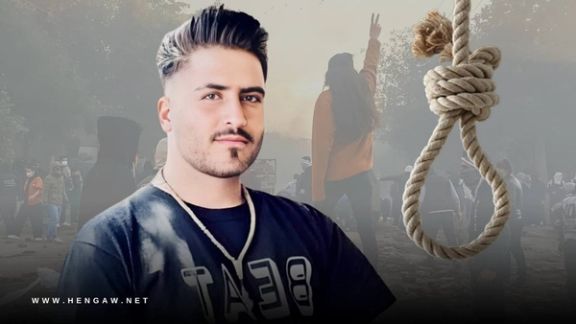Execution Threat For Kurdish Sunni Prisoners In Iran

Religious prisoner Ayub Karimi was moved to solitary confinement last week in preparation for imminent execution in Ghezel-Hesar Prison in Karaj.

Religious prisoner Ayub Karimi was moved to solitary confinement last week in preparation for imminent execution in Ghezel-Hesar Prison in Karaj.
The prisoner, a SUnni Kurd, is the latest case rights groups fear will be victim to Iranian crackdowns on dissenting voices among the country's minorities.
According to Hengaw Organization for Human Rights, one week ago, the Kurdish religious prisoner, the father of two children, was taken to the solitary confinement wing.
It follows the execution on November 5 of fellow religious prisoner Ghasem Abesteh, one of Karimi's co-defendants.
Hengaw said that along with Karimi, five more religious prisoners have been identified as also facing imminent execution, Davoud Abdollahi, Farhad Salimi, Anwar Khezri, Khosrow Besharat, and Kamran Sheykha.
All of them were taken into custody in 2009 and were transferred to the detention center of the intelligence agency in Urmia (Orumiyeh) City.
They were tried in 2015, and subsequently sentenced to death. These sentences were confirmed by the Supreme Court in 2020, after years of legal battles. Despite a request for retrial in September 2020, the Supreme Court rejected their plea.
The charges against them include "War against God," "corruption on earth," "support for Salafi groups," and the alleged "murder" of Abdolrahim Tina, who was killed by unidentified assailants in September 2008. However, in letters published by human rights organizations in recent years, the accused individuals consistently denied any involvement in these accusations.
In July alone, Kurdistan Human Rights Network reported that in the past month, Iranian security forces detained at least 54 Kurdish activists and citizens in the western provinces of Iran. Two detainees were sent to prison while the fate of the rest, including two children, remains unknown.

The United States on Sunday deployed its Dwight D. Eisenhower aircraft carrier task force to the Persian Gulf amid continuing tensions in the Middle East.
The US military announced that the Carrier Strike Group Eisenhower (IKECSG) completed a transit of the Strait of Hormuz to enter the waters of the Persian Gulf to support US Central Command missions.
Following the October 7 terror attack on Israel by Hamas and the start of the Gaza war, the US first deployed two strike groups to eastern Mediterranean in what appeared as a deterrence against the Lebanese Hezbollah. The Shiite militant group is believed to possess tens of thousands of missiles and rockets that could bring destruction to Israel. The Hezbollah has since engaged in limited border skirmishes but has avoided a full-scale war with Israel.
Iran’s regime has also chosen not to directly get involved in the Gaza war, although officials issue daily statements of support for Hamas.
The US said that the IKECSG are patrolling the Persian to ensure freedom of navigation in key international waterways while supporting CENTCOM requirements throughout the region.
Iranian officials periodically threaten to close off the Strait of Hormuz or inspect vessels. They have attacked and harassed dozens of commercial vessels in the region since 2019.
“The aircraft carrier USS Dwight D. Eisenhower was accompanied by the guided-missile cruiser USS Philippine Sea, guided-missile destroyers USS Gravely and the USS Stethem and the French frigate Languedo,” the USCENTCOM said.

A political prisoner has called on Iran's chief justice to investigate his revelation that dissident rapper Saman Seydi (Yasin) was subjected to mock execution.
In an open letter addressed to Chief Justice Gholamreza Mohseni-Ejei Thursday, Ahmadreza Haeri has offered more details about the mock execution of a former fellow inmate Yasin, at Ward 240 of Tehran’s Evin Prison.
Yasin whose death sentence was overturned by the Supreme Court in December, in audio files smuggled from prison, has described severe torture including a mock execution during which he was forced to stand on a chair with a noose around his neck after being told to write his last will and testament.
“He is young. One must show mercy. Try to place the noose sideways so that his neck breaks right away when he drops so he doesn’t suffer too much,” Yasin says one of his supposed executioners said to the other.
Then, he says, there was a call after which he was told the execution had been delayed giving him “another chance to cooperate”. Two days later, a real death sentence was handed to him. His wife miscarried her eight-month baby after finding out about the death sentence.
Yasin (27) belongs to the persecuted Kurdish Yarsan religious community and was a vocal critic of the regime before his arrest for supporting the anti-government protests known as the Woman, Life, Freedom movement. He has only attended the court once during his fourteen months of imprisonment and does not have access to his lawyer.

“Form a fact-finding committee consisting of independent lawyers and judges to investigate this matter and allow independent journalists and reports to monitor the committee’s performance,” Haeri wrote.
Haeri alleges that Yasin was taken from his cell in the middle of night and subjected to a mock execution to force him to accept fabricated charges including the use of a combat weapon during last year’s anti-government protests, which would justify a death sentence sought by the prosecutor against him.
According to Haeri, tens of other prisoners heard Yasin’s account of the torture and mock execution he had undergone when he was taken back to the general ward, mentally and physically shattered.
Haeri, a lawyer and human rights activist, is serving a sentence at Ghezel Hesar Prison for exposing the beating of other prisoners at Tehran’s infamous Fashafouyeh Prison in 2014, which led to the death of two inmates, during an incident which came to be known as “Black Thursday”.
State-affiliated media such as the Revolutionary Guards (IRGC) linked Tasnim news agency claimed Wednesday that a new case has been opened against Haeri for not being able to provide proof for the claim in his letter earlier this week that Yasin was subjected to mock execution.
Many other political prisoners and prisoners of conscience have claimed that they were subjected to mock executions to extract confessions that would justify harsh sentences including Sahand Noor-Mohammad-Zadeh, 26, an anti-government protester.
He was accused of setting a trash bin on fire and blocking traffic, both of which he denied. But he had several times been blindfolded and told to climb a chair to be hanged before his trial. He was sentenced to death for moharebeh (enmity against God) and was executed on November 2 last year.
Another protester, Majid Kazemi, said he had undergone mock executions at least fifteen times, in addition to other tortures including upside down suspension and showing him a video of his brother being tortured to “confess” to whatever was dictated to him. Kazemi was also executed on May 19 for “enmity against God”.
In a statement on November 23, the US State Department condemned mock executions and torture of prisoners in Iran with the hashtag #SamanYasin and called on the Iranian authorities to immediately stop “these inhumane practices and conduct fair and transparent trials for their citizens.”

Iran’s former President Hassan Rouhani has for the first time discussed possible arrangements to handle the situation after Supreme Leader Ali Khamenei's death.
He told a group of Iranian moderates including his aides in the previous government on November 20, "This round of the Assembly of Experts election, which is to be held on March 1…, is more important than the previous elections." The Assembly has the constitutional task to select the next Supreme Leader.
Using the mildest language to evade Khamenei’s and his hardliner supporters' anger, Rouhani said, "May the Supreme Leader live long, but as the time passes, the day we would never want to come is more likely to arrive and the Assembly of Experts has to decide on the naming of the next Supreme Leader."
Rouhani added that he had his doubts about whether to register his candidacy for the Assembly of Experts election and that he finally decided to run hoping that he can make an impact on the Assembly's choice in the event of Khamenei's death.
Over the past weeks, when Rouhani revealed that he was a candidate and particularly after the official announcement about the endorsement of his credentials, many conservative media and politicians expressed their opposition to his candidacy although he already is an incumbent member of the assembly. Earlier, a state TV presenter asked the Guardian Council on live television to disqualify him.
Rouhani said at the meeting with his aides that the state TV is at its lowest point in terms of popularity and people's trust.

He said he is well familiar with the hardliners who are currently in control of the government and parliament, adding they would do anything to make sure that he cannot run. However, he insisted that he would encourage everyone to take part in the elections.
Many in the reformist and moderate camp consider Rouhani as one of the three potential candidates for the Supreme Leader, along with President Ebrahim Raisi and Khamenei's son Mojtaba.
Although Iran's reformist and moderates may not like it, but under the current circumstances Rouhani is the least likely winner in this imaginary contest. He is the least popular member of the hardliner dominated Assembly of Experts. From this perspective, Raisi has a better chance to be the Islamic Republic's next leader. In fact, thanks to his naivety, he could be the ideal supreme leader for a country to be run by a powerful and ambitious entity such as the IRGC.
In an alternative scenario, suggested by some Iranian analysts, Raisi is considered the most suitable candidate to succeed former Guardian Council Secretary Ahmad Jannati at this point. This move could strategically position Raisi to carry out Khamenei's directives effectively and potentially pave the way for the ascension of Khamenei's son, Mojtaba, to power.
In recent years, Khamenei has been grooming Mojtaba for the post. Mojtaba has been teaching a much-advertised high profile advanced course at the seminary in Qom and the state TV frequently referred to his seminary credentials. The Supreme Leader should be a learned Imam according to the regime’s ideology.
Some say even Rouhani could be a player in helping Mojtaba. He said recently that the next Supreme Leader need not need be a Mojtahid (a cleric high ranking enough to confer his own religious decrees). Of course, he could expect a reward for playing the part. A reward such as a guaranteed high-ranking position to keep for life. A position in which he could distribute power and money and exercise his influence on the political apparatus without causing any nuisance for the next leader.
Unlike countries such as Saudi Arabia and Jordan, Iran lacks an official position like that of a crown prince designated as the official heir to the current Supreme Leader. This raises concerns about the country's stability, particularly in the immediate aftermath of what Rouhani referred to as "The day we would never want to come."

While billions are poured into Iran's military infrastructure and regional proxies, there has been no budget allocated for the preservation of historical monuments.
Ezzatollah Zarghami disclosed that “a budget of 15,000 billion rials (equivalent to 30 million USD) was earmarked for the development of the cultural heritage ministry, with a portion specifically designated for the restoration of historical and cultural monuments. However, due to the challenges faced by the country, the budget has not been disbursed to the ministry.”
The minister did not elaborate on the nature of the challenges but expressed hope that the funds would be provided later.
The situation is exacerbated by a broader historical trend since the 1979 Islamic Revolution, which has seen a nonchalant approach towards pre-Islamic relics. Despite Iran's profound historical legacy, the present regime has not fully embraced its rich heritage, even though the country once presided over the world's largest empire.
Previous instances, such as the announcement in September 2020 by then Minister Ali Asghar Mounesan of a meager annual budget of 50 million rials (approximately 100 USD) for the management of Persepolis, reflect a systemic issue in adequately allocating funds for the preservation of cultural treasures.
Despite warnings from cultural heritage experts, the inauguration of the Chamshir Dam in the Kohgiluyeh and Boyer-Ahmad province on July 17 proceeded. Archaeologists predict that the impoundment of the dam will result in the loss of at least 140 historical monuments in the region, underscoring the destructive consequences of inadequate attention and funding for Iran's cultural heritage.
In May, the government announced plans to auction off some of the country's most treasured sites including Rayen Castle as the country's heritage risks disappearing amidst a government more concerned with its nuclear and military might than its ancient history.

Milad Zohrevand, secretly executed in Hamadan prison for his part in protests last year, has been denied burial in a Muslim cemetery and his parents arrested during his funeral.
The Hengaw Human Rights Organization claims regime authorities refused permission for his body to be transferred to the Muslim cemetery of Malayer, and after his burial in the Armenian cemetery of Hamadan, they poured concrete over his grave.
The burial ceremony, held on Saturday, took place under stringent security measures, with only a few family members in attendance.
On Sunday, the Iranian Human Rights Organization announced that Afsaneh Zohrevand, Milad's mother, was detained during her son's funeral on charges of "disturbing the peace."
Twitter account Dadban also reported on Sunday that Milad Zohrevand's father, Rouhollah, was arrested after the burial ceremony and transferred to prison. As of now, the reasons for his arrest and his current status have not been disclosed.
Milad Zohrevand had been sentenced to death in connection with trumped up charges of "killing" of an IRGC officer named Ali Nazari during the Woman Life Freedom protests in which more than 500 civilians were brutally murdered
Amnesty International has condemned Zohrevand's execution, the eighth related to the 2022 protests sparked by the death in morality police custody of Mahsa Amini, calling it a systematic use of extrajudicial executions by the Islamic Republic as a tool of suppression.